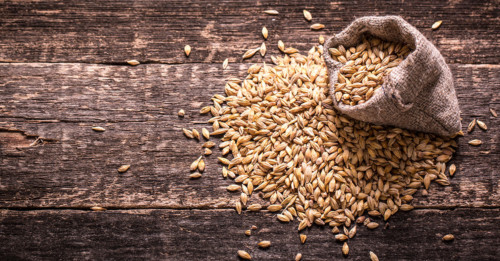It’s tempting to say every ingredient is the most important ingredient in beer. At least we know which relationship is probably the most important—the timeless, bubbly love story between malted grain and yeast.
As we discussed, when we make beer, yeast feasts on sugar, metabolizing alcohol and CO2. And while that sugar can come from a variety of sources—including starches like corn, oats, rice, and sorghum*—the most commonly used starch in beer production is barley.
A high starch grain, barley actually looks a lot like wheat (that other beer-friendly cereal grain). Recent archaeological evidence shows that barley was likely first cultivated in the agriculturally prolific area of the Middle East known as the Fertile Crescent about 10,000 years ago (and from there to South Asia, and from there, the world). Barley is now widely cultivated around the world, though around 94% of production goes to beer. And that shouldn’t surprise, since barley can grow in fairly rough conditions and yields a solid 65% starch content (the more starch there is, the more sugar there is, the more the yeast eats, the more we drink!).
Before barley can be used, though, it has to be malted, or allowed to partially germinate, soaked, and dried, a process that prepares its starches for quicker conversion into sugar. Grains are kilned to stop the malting process, or dried and/or darkened using a heat source (old school heat source: fire). But any grain in beer can also be aggressively roasted, which will have a major impact on the resulting flavor of the beer (think of the difference between a pale ale and a stout). It’s pretty straightforward: the longer a grain is roasted, the darker the resulting beer. Typically, only a certain proportion of the grain used will be roasted; the total “grain bill” for a beer will be made up of a high percentage of “base malt,” which provides the majority of fermentable sugars, and a smaller percentage of other grains, which help build up the desired flavor profile.
Depending on how hands-on they’d like to be, brewers have the choice of either using a raw grain (and malting it themselves), purchasing the grain malted, or using a malt extract, which is an extraction of the malted grain that can go directly into the boil. There’s less opportunity for personal touch in that last option, but you’ll still end up with a very respectable beer, so it’s a great option for new brewers.
Malts can also be divided as to how they’re used, e.g. “base malts” and “specialty malts.” For instance, Crystal malts are commonly used as a specialty malt to impart toffee or caramel-like sweetness (that may or may not linger on the finish, depending on a beer’s style). Black malts are super-kilned barley malts that can be used to darken color or taste. Pilsner malt, on the other hand, is a super pale malt used in (or as) the base of a lager, with a good amount of flavor and some sweetness despite its pale color. The list, because beer is a delicious rainbow, goes on.
Chances are, you open a bottle and take a sip, you’ll know if the grain fits your bill.
